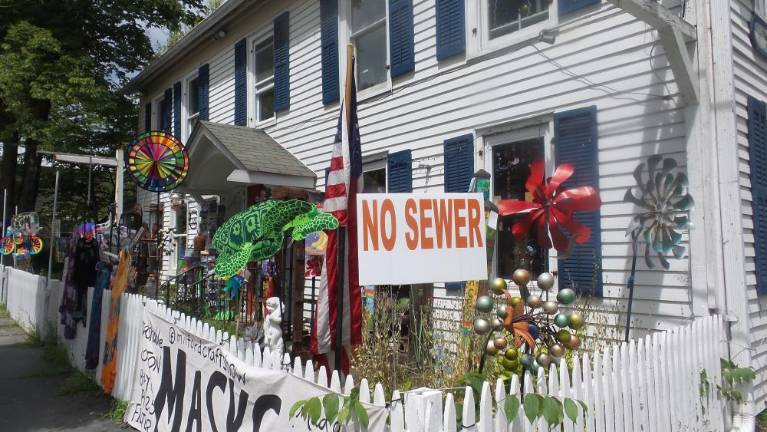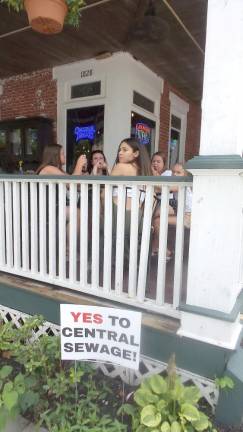The sewer war is on
Milford. Advocates say a central system would bring renewed investment to the communities it serves, while opponents say it will bring unsustainable development that will degrade a treasured way of life and put more treated effluent into the Delaware River.



“Yes to central sewage” signs tango with “No sewer” signs all around Milford, reflecting the viewpoints of residents and business owners on opposite ends of the debate.
A proposed central sewage system that would connect four municipalities -- Milford Borough, Milford Township, Westfall Township, and Matamoras Borough -- is at the center of the controversy. Advocates say a central system would bring renewed investment to these communities, while opponents say it will bring unsustainable development that will degrade a treasured way of life and put more treated effluent into the Delaware River.
On the “yes” side is Mayor Sean Strub, who says the lack of a central sewage system is hurting businesses whose undersized and malfunctioning systems are keeping them from expanding.
“It’s one reason why The Tom Quick hasn’t sold,” said Strub. “Look at underutilized or vacant commercial properties. If they were connected to central sewage, there are many more uses for which they could be used.”
He also said a central system would also benefit the community’s health, sanitation, and environment.
A draft of the central sewage plan, called Act 537, disappeared from the township’s website. You may read it by clicking on this link. The plan was never posted on the borough’s website.
Strub said the plan doesn’t decide anything. “I’ve already had someone argue with me that this is ‘the plan,’ and it is not,” he said. “This is the draft that we start with to begin the process to make it ours.”
Strub said it only lays out the process required for municipalities to explore the need for central sewage and what types of systems are feasible.
Another error the “antis” commonly make is that borough taxpayers will be paying for it, Strub said. “They aren’t,” he said. “Not a penny.”
The project will be paid for entirely by grants earmarked for central sewer systems and the businesses connected to the system, he said. It would not cost anyone a dime if they weren’t located on the route of the sewer line, he said.
Quality of life
Among those on the “no” side are 18 borough residents who signed a petition asking officials to wait for the pandemic to end so they can discuss the issue face to face. Councilman Frank Tarquinio said Pennsylvania’s Sunshine Law would prohibit this request. But several of the signers said their comments could be muted or deleted during Zoom sessions, and that they were unsure whether they were actually being heard.
Ed Gragert said he and his wife bought their house in Milford Township in 1983, attracted by the area’s natural beauty and quality of life. “However,” he said, “recently there has been a trend toward creating more and more space for industry and commerce — at the expense of residential and recreational use.”
He said the proposed zoning regulations for Milford Township may be changed to allow large-scale development on the three-lane highway north of the borough. “Proposals that include high-priced and multi-family rentals and commercial development are pushing for sewer installations to make their high-density development possible,” he said. These developers will eventually move on, he said, leaving residents to pay sewage connection fees, deal with traffic density, and a degraded environment.
Fred Weber said support for central sewage is limited to “approximately 6-7 commercial establishments in the Broadstreet and Harford corridor who believe central sewage is the answer to their problems even though at this point, I don’t think these establishments know what cost they will have to bear on a monthly basis.”
He said the sewage treatment plant in Westfall will dispense 330,000 gallons a day of treated sewage directly into the Delaware upstream from the borough. “The Delaware is the crown jewel of the county, and many residents are concerned about its future,” Weber said. “Once the sewer pipes are in and running through Milford Township, there will more than likely be continued high-density, big box development along the 6/209 corridor. Ultimately, the small town ambiance and charm of our area will be irrevocably altered.”
Erica Burnett is also concerned about putting more treated waste into the Delaware. “I was born and raised here in Milford and returned home after graduating from Portland State University in Oregon,” she said. “I loved my time in the city, but quickly realized that I missed the country and the small town way of life. I am now raising my family here and want to preserve the small town charm that Milford embodies.”
She said she understands that growth and change are inevitable, but feels the sewer line will lead to an “uncontrolled explosion of growth.”
“With the exception of the Tom Quick Inn, most of these businesses have been operating for decades,” she said. “I do not feel that the financial burden of the sewer should be placed on the other small businesses along our main street as well as the residences along the line that will be forced to connect. I was saddened to hear that different sewer line routes were the only alternatives considered in solving this problem. I remember hearing about a more environmentally friendly system that was proposed years back that would not increase the waste flow into the beautiful Delaware River. As a community, we should be protecting this treasure.”
Bill Kiger said “the bottom line question for many of us is, ‘Do we really need sewers?’ The town is mature development-wise with little room to grow and an almost perfect mix of restaurants, retail, and services. And, with prominence as the ‘Home of the American Conservation Movement,’ possibly there is an opportunity to become the region’s green laboratory for emerging septic solutions with a funding boost from the state.
“And, do we need to monkey with tourism, Milford’s lifeblood economy? With its history, architectural heritage, and burgeoning cultural life, Milford is a ‘diamond’ destination to the tourist crowd. And we haven’t even touched the unsettled variables of costs and funding.”
A much-discussed project
After 50 years of discussion, the borough council voted in February 2019 to enter into an inter-municipal agreement to study connecting Milford Borough’s commercial district to the Westfall Municipal Authority plant. The system would serve only the commercial thoroughfares of Harford and Broad Streets.
The council is now reviewing the draft plan and making revisions. Residents will then have a chance to provide input, which will be addressed in the plan. Once the plan is finalized, it will be sent to the planning commissions for review. It will after that be submitted to the Pennsylvania Department of Environmental Protection and to the Delaware River Basin Commission, which controls the quality and quantity of all discharges into the Delaware River.
Councilman Joseph Dooley noted that the project has already been much discussed. “Our borough council has discussed in one form or another the central sewage study a total of 23 times during regular council meetings or public workshops going back to 2018,” he said.
Mayor Strub said opponents are saying the council is “not being forthcoming or trying to quietly push something through, which is absolutely false. The process was discussed and defined at the beginning and followed ever since.”
Councilman Tarquinio said the ultimate decision rests with the council, “since they are responsible for the health, safety and welfare of the borough. It also would not be fair to have the majority of the borough make that decision for others. Most residents will not be connected nor will they pay any money to it either upfront or ongoing through taxes or other fees. By electing us, the citizens have entrusted us with making that decision for the good of the borough.”
Tarquinio said the pandemic threw into relief “the vital role that restaurants and food service establishments play in a community’s vitality and economic stability.”
He said tourism depends on a viable downtown. “Restaurant life is at the heart of Milford Borough, and these restaurants struggle with their sewage issues,” Tarquinio said.
Editor’s note: The draft plan disappeared from the township’s website, not the borough’s website, as was incorrectly stated in the original version of this article. The draft plan was never posted on the borough’s website. The Courier regrets the error.
“I was born and raised here in Milford and returned home after graduating from Portland State University in Oregon. I loved my time in the city, but quickly realized that I missed the country and the small town way of life. I am now raising my family here and want to preserve the small town charm that Milford embodies.” --Erica Burnett
“Look at underutilized or vacant commercial properties. If they were connected to central sewage, there are many more uses for which they could be used.” --Mayor Sean Strub
“The Delaware is the crown jewel of the count,y and many residents are concerned about its future. Once the sewer pipes are in and running through Milford Township, there will more than likely be continued high density, big box development along the 6/209 corridor. Ultimately, the small town ambiance and charm of our area will be irrevocably altered.” --Fred Weber
“With the covid-19 epidemic, the vital role that restaurants and food service establishments play in a community’s vitality and economic stability has gained visibility, but it has always been at the center of the economy and vitality of the commercial district of Milford. We depend on the tourist trade for a viable downtown. Restaurant life is at the heart of Milford Borough and these restaurants struggle with their sewage issues.” --Councilman Frank Tarquinio